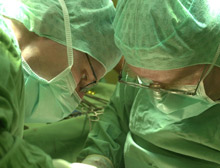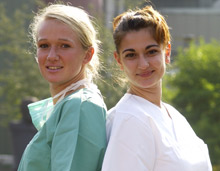The Bielefeld Mitte City Hospital, with its two sites at Centre and at Rosenhöhe, is the largest acute care hospital in Bielefeld and the surrounding area. Equipped with a range of special disciplines, unique in east Westfalia-Lippe, it is essential to the healthcare of the people in the region.
The 17 clinics and institutes within the facility are highly specialised and provide a high level of medical care. Some 2,000 people work in the various areas of the facility, which has around 1,000 beds, and which since 1977 has been the academic teaching hospital for the Westfalian Wilhelms University of Münster.
As one of the largest employers in the city, the hospital is an important business, which needs to run its procedures as effectively as possible. With 2,000 members of staff, duty rosters and time management are naturally very important. In earlier times duty rosters were drawn up manually and timesheets were written out, signed by superiors and then entered manually into the payroll program. "This process was very time-consuming and old-fashioned," said Ulrich Winkelbach, Personnel Manager at the Bielefeld Central City Hospital. "We therefore set out in search of an electronic solution for our staff planning and payroll."
The new system needed to make work scheduling much easier, and provide all the relevant payroll information for payment. Of course, it was necessary for all collective pay provisions to be included. In their search they came across the PER-RES (Personnel Resources Management System) time management system supplied by mgm Gesellschaft für Organisationsberatung, Information und Datenverarbeitung im Gesundheitswesen mbH of Grünstadt, a specialist in hospital systems. "We tested the program very intensively and quickly ascertained that the system suited our needs very well," explained Ulrich Winkelbach. 
The electronic time-recording system was implemented in stages. Following a pilot phase at the intensive care station in the Rosenhöhe hospital, the system was gradually expanded to cover all care and function areas, such as anaesthetics. The first step was to implement the electronic duty roster planning with negative time-recording. This meant that actual working hours were not actively recorded. When it came to working out the payroll, the scheduled times were automatically taken to be the actual hours worked. However, in practice there were constantly variations. Staff had to write out any changed work times, get it signed by their superior and this then had to be entered into PER-RES manually. "We wanted to save ourselves that work," said Personnel Manager Winkelbach, explaining the decision to implement the electronic time-recording system as the next step.
On a recommendation from mgm the decision was made to purchase Kaba time-recording terminals. These were adapted to the special requirements of the hospitals. For this reason, a unique "passe-partout" was developed for the terminal B-Net 93 60 which allows users to make special additional entries. Thus, employees can select a number of special entries to make, e.g. child ill, change from regular to stand-by duty, training, stand-by duty, available for work on call, available for stand-by or overtime, etc. A total of 12 B-Net 93 40 and B-Net 93 60 time-recording terminals were installed at the various entries to the building.
Once a works agreement had been signed in November 2005, the project began with a test run at 4 nursing stations, in the Rosenhöhe operating hospital, in certain technical departments, in IT and personnel department, the cleaning company and the works council.
Once it was seen that there were no problems of note, the time-recording system was gradually extended from April 2006 to all departments that produce their duty rosters using PER-RES. Members of staff use their LEGIC key fobs not only to enter their worked hours, but they can also use the terminal to find out the status of their time and holiday accounts. In addition, the LEGIC chip for cashless payment can be used to pay for items in the canteen. The special function keys relieve the ward clerks at the nursing stations and the personnel department.
 "Time-recording on terminals makes the work at our nursing stations very much easier, because we no longer need to follow up manually," stressed Winkelbach. "Right from the start the terminals operated without problem. So far the system has proved to be totally reliable. With regard to economy, our expectations have been met. We now have an automated process, from duty rosters, time-recording, and payroll accounting, which saves us a great deal of time. The administrative work has reduced considerably."
"Time-recording on terminals makes the work at our nursing stations very much easier, because we no longer need to follow up manually," stressed Winkelbach. "Right from the start the terminals operated without problem. So far the system has proved to be totally reliable. With regard to economy, our expectations have been met. We now have an automated process, from duty rosters, time-recording, and payroll accounting, which saves us a great deal of time. The administrative work has reduced considerably."












